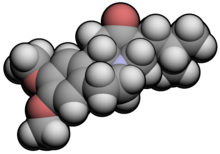Tetrabenazine
 | |
 | |
| Clinical data | |
|---|---|
| Trade names | Xenazine, Nitoman |
| Synonyms | Ro-1-9569 |
AHFS/Drugs.com | Consumer Drug Information |
| Pregnancy category |
|
| Routes of administration | Oral (tablets) |
| ATC code |
|
| Legal status | |
| Legal status |
|
Pharmacokinetic data | |
| Bioavailability | Low, extensive first pass effect |
| Protein binding | 82–85% |
| Metabolism | Hepatic (CYP2D6-mediated) |
| Excretion | Renal (~75%) and fecal (7–16%)[1] |
| Identifiers | |
IUPAC name
| |
| CAS Number |
|
PubChem CID |
|
| IUPHAR/BPS |
|
| DrugBank |
|
| ChemSpider |
|
| UNII |
|
| KEGG |
|
| ChEMBL |
|
| ECHA InfoCard | 100.000.348 |
| Chemical and physical data | |
| Formula | C19H27NO3 |
| Molar mass | 317.427 g/mol g·mol−1 |
| 3D model (JSmol) |
|
| Chirality | Racemic mixture |
SMILES
| |
InChI
| |
.mw-parser-output .nobold{font-weight:normal} (verify) | |
Tetrabenazine is a drug for the symptomatic treatment of hyperkinetic movement disorders. It is marketed under the trade names Nitoman in Canada and Xenazine in New Zealand, some parts of Europe, and in the United States as an orphan drug and in Iran as Xentra. On August 15, 2008, the U.S. Food and Drug Administration approved the use of tetrabenazine to treat chorea associated with Huntington's disease. Although other drugs had been used "off label," tetrabenazine was the first approved treatment for Huntington's disease in the U.S.[2] The compound has been known since the 1950s.
Contents
1 Medical uses
2 Side effects
3 Warnings
4 Pharmacology
5 See also
6 References
7 External links
Medical uses
Tetrabenazine is used as a treatment, but not as a cure, for hyperkinetic disorders[3][4] such as:
Huntington's disease – specifically, the chorea associated with it
Tourette syndrome and other tic disorders
Tardive dyskinesia,[5] a serious and sometimes irreversible side effect of long-term use of many antipsychotics, mainly typical antipsychotics
Hemiballismus, spontaneous flinging limb movements due to contra-lateral subthalamic nucleus damage
Side effects
The most common adverse reactions, which have occurred in at least 10% of subjects in studies and at least 5% greater than in subjects who received placebo, have been: sedation or somnolence, fatigue, insomnia, depression, suicidal thoughts, akathisia, anxiety and nausea.[1]
Warnings
There is a boxed warning associated with the use of tetrabenazine:[1]
- Increases the risk of depression and suicidal thoughts and behavior in patients with Huntington's disease
- Balance risks of depression and suicidality with the clinical need for control of chorea when considering the use of tetrabenazine
- Monitor patients for emergence or worsening of depression, suicidality or unusual changes in behavior
- Inform patients, caregivers and families of the risk of depression and suicidality and instruct to report behaviours of concern promptly to the treating physician
- Exercise caution when treating patients with a history of depression or prior suicide attempts or ideation
- Tetrabenazine is contraindicated in patients who are actively suicidal and in patients with untreated or inadequately treated depression
Pharmacology
The precise mechanism of action of tetrabenazine is unknown. Its anti-chorea effect is believed to be due to a reversible depletion of monoamines such as dopamine, serotonin, norepinephrine, and histamine from nerve terminals. Tetrabenazine reversibly inhibits vesicular monoamine transporter 2, resulting in decreased uptake of monoamines into synaptic vesicles, as well as depletion of monoamine storage.[1]
See also
- Deutetrabenazine
References
^ abcd "Xenazine (tetrabenazine) Tablets, for Oral Use. Full Prescribing Information. Revised: 6/2015" (PDF). H. Lundbeck A/S. Retrieved 9 December 2015..mw-parser-output cite.citation{font-style:inherit}.mw-parser-output .citation q{quotes:"""""""'""'"}.mw-parser-output .citation .cs1-lock-free a{background:url("//upload.wikimedia.org/wikipedia/commons/thumb/6/65/Lock-green.svg/9px-Lock-green.svg.png")no-repeat;background-position:right .1em center}.mw-parser-output .citation .cs1-lock-limited a,.mw-parser-output .citation .cs1-lock-registration a{background:url("//upload.wikimedia.org/wikipedia/commons/thumb/d/d6/Lock-gray-alt-2.svg/9px-Lock-gray-alt-2.svg.png")no-repeat;background-position:right .1em center}.mw-parser-output .citation .cs1-lock-subscription a{background:url("//upload.wikimedia.org/wikipedia/commons/thumb/a/aa/Lock-red-alt-2.svg/9px-Lock-red-alt-2.svg.png")no-repeat;background-position:right .1em center}.mw-parser-output .cs1-subscription,.mw-parser-output .cs1-registration{color:#555}.mw-parser-output .cs1-subscription span,.mw-parser-output .cs1-registration span{border-bottom:1px dotted;cursor:help}.mw-parser-output .cs1-ws-icon a{background:url("//upload.wikimedia.org/wikipedia/commons/thumb/4/4c/Wikisource-logo.svg/12px-Wikisource-logo.svg.png")no-repeat;background-position:right .1em center}.mw-parser-output code.cs1-code{color:inherit;background:inherit;border:inherit;padding:inherit}.mw-parser-output .cs1-hidden-error{display:none;font-size:100%}.mw-parser-output .cs1-visible-error{font-size:100%}.mw-parser-output .cs1-maint{display:none;color:#33aa33;margin-left:0.3em}.mw-parser-output .cs1-subscription,.mw-parser-output .cs1-registration,.mw-parser-output .cs1-format{font-size:95%}.mw-parser-output .cs1-kern-left,.mw-parser-output .cs1-kern-wl-left{padding-left:0.2em}.mw-parser-output .cs1-kern-right,.mw-parser-output .cs1-kern-wl-right{padding-right:0.2em}
^ 1st US drug for Huntington's disease wins approval[dead link]
^ Jankovic J, Beach J (1997). "Long-term effects of tetrabenazine in hyperkinetic movement disorders". Neurology. 48 (2): 358–62. doi:10.1212/wnl.48.2.358. PMID 9040721.
^ Kenney C, Hunter C, Jankovic J (January 2007). "Long-term tolerability of tetrabenazine in the treatment of hyperkinetic movement disorders". Movement Disorders. 22 (2): 193–7. doi:10.1002/mds.21222. PMID 17133512.
^ Ondo WG, Hanna PA, Jankovic J (August 1999). "Tetrabenazine treatment for tardive dyskinesia: assessment by randomized videotape protocol". American Journal of Psychiatry. 156 (8): 1279–81. doi:10.1176/ajp.156.8.1279 (inactive 2018-09-04). PMID 10450276.
External links
- Xenazine prescribing information FDA
- NIMH Repository data sheet
"Tetrabenazine"[permanent dead link] from HOPES: Huntington's Disease Outreach Project for Education at Stanford- Detailed monograph on tetrabenazine on rxmed.com
- Information on tetrabenazine from netdoctor.co.uk

Comments
Post a Comment